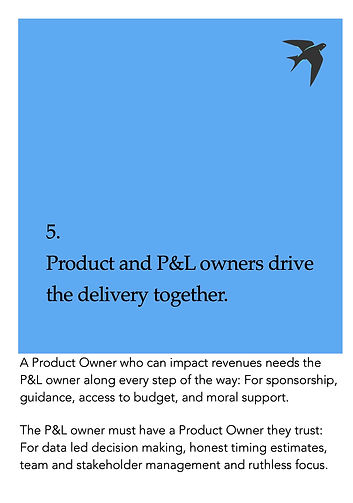top of page

In Your Power
What are the problems that organisations never feel they have truly solved?
Our new 'In Your Power' series looks into areas we have seen organisations waste time, energy and focus on: with the aim of providing simple, practical and actionable pieces of advice.
The first in our series focuses on how digital and product management sits in the organisational operating model: Selecting priorities, empowering teams and timely delivery will be touched on with five insights over the next five days.
If you are interested to learn more about our digital delivery assessment and projects please email: contact@pagemartlet.com

Get the CEO involved.
Is your product roadmap a statement of intent or finely balanced set of political tradeoffs?
Having the CEO or MD engaged in of the product roadmap discussion can help ensure that the resources are focused on the right short and long term objectives.
Reducing the number of items for delivery while demanding evidence of discovery, research and the right available talent will ensure a more 'honest' prioritisation process.
If a board member is going to have their ability to deliver hampered by a lack of digital support then the CEO needs to own that decision.

Targets require strategic context.
Is it possible to get it right and very very wrong?
Having measures (and even targets) can be helpful to teams working on digital products; increased dwell time, reduced cancellations, increased page views, increased sales conversions, increased repeat visits - revenue and engagement metrics all help the team understand the priorities of the organisation.
However a structure that is too focused on the numbers risks accidental damage to other business objectives:
> reductions in cancellation (by making the hard or impossible) damage customer perceptions.
> increased engagement through low quality content reduces the value of a brand.
> conversion journeys that are too quick result in greater cancellations and returns.
The product owner is accountable for ensuring that a balanced product is built, the organisation is accountable for reinforcing the right behaviours through the governance and rewards systems.

Set scope guide-rails and recognise expertise.
Why do I hear so many complaints from my team when they are finally getting their problems prioritised?
Getting the dynamic of a X-functional team right is a challenge: differing experiences, long held opinions, status and ego are just a few of the ingredients that destabilise teams.
Providing a clear scope for the discovery process is essential, time spent discussing topics/changes that are outside the power of the team should be quickly moved to the ‘parking lot’.
A X-functional team should invite contributions from all team members, developers, researchers, ‘business’ representatives but it is essential to provide space for expertise to be shared and respected.
Small sample sizes, cherry picked data, poorly run research interviews and focus groups all risk building cynicism that data is being used to promote a bias of powerful individuals in the group. If the data is challenged address it and agree if it is valid.
Allow experience to enrich and speed up the discovery and development process.

Discipline in discovery drives delivery.
Are we nearly there yet?
There is a tendency for development processes to run longer than estimated through a lack diligence in discovery - resulting in senior stakeholders becoming frustrated and demanding deadlines for completion.
Bringing teams together to look at competitors and adjacent businesses, to conduct focus groups and user testing, to run 404 tests, and gather any other data points before development is essential.
Allowing time for ideas to formulate, be adopted or fall by the wayside and to be tested again before the development process starts will condense delivery times.
Ensuring that resources that aren’t 100% committed to the team are available when you need them will maintain momentum - In particular UX designers, copywriters and data experts are often in short supply.

Product and P&L owners drive the delivery together.
How can I still ‘own’ the P&L if my success is down to the product team?
The proposition, copy, user journeys, design and even branding are a/b tested and optimised by a team (maybe X-functional) that is empowered to deliver results … how does the traditional business owner add value and stay engaged?
The P&L owner needs to stay close to the team, participating in stand ups and workshops, working shoulder to shoulder with the product owner to provide two key roles;
> Firstly to provide strategic context, results focus and the link to the rest of the organisation.
> Secondly to keep the team oriented towards their main objective - and be willing to pause or stop any efforts that could be a distraction.
A Product Owner without the P&L owner will find their role too broad (the demands of communication and collaboration with the rest of the organisation) and their focus on delivering an excellent product weakened.
Success delivered through great products is a result of focus, clear roles and teamwork.
bottom of page
